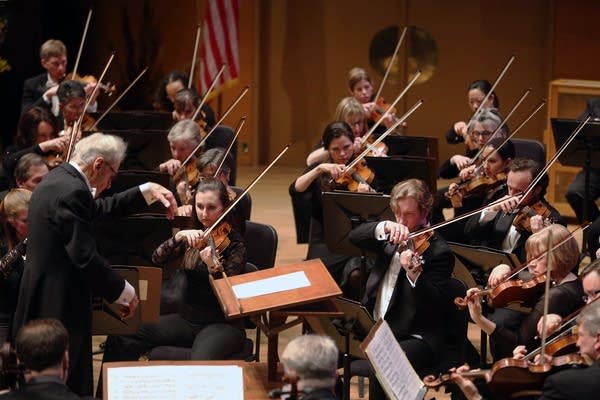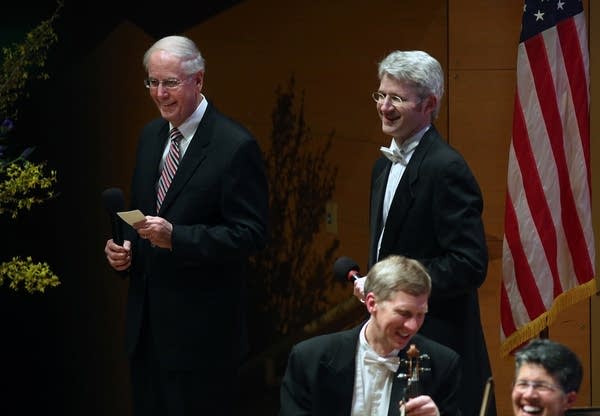A look back at the Minnesota Orchestra's tumultuous year of rebuilding

Go Deeper.
Create an account or log in to save stories.
Like this?
Thanks for liking this story! We have added it to a list of your favorite stories.
On Jan. 14, 2014, the Minnesota Orchestra's locked-out musicians called a press conference in downtown Minneapolis.
They were ending the 16-month stalemate, and had come to a settlement with the orchestra's management.
Since then, the Minnesota Orchestra has had an extraordinary year.
MPR News arts reporter Euan Kerr covered the lockout, and has been watching the orchestra's recovery. He offers his take on the year of rebuilding.
Turn Up Your Support
MPR News helps you turn down the noise and build shared understanding. Turn up your support for this public resource and keep trusted journalism accessible to all.

How are things playing out now at the Minnesota Orchestra?
In recent days at Orchestra Hall, I've repeatedly heard the word "optimistic." The Orchestra is playing well, and musicians are clearly happy to be working with music director Osmo Vanska again.
The settlement increased the number of purely classical concerts, and the musicians I talked with say that challenge makes them a better orchestra.
Since the settlement, there has been more musician involvement in artistic decisions such as repertoire choice, and that is reportedly going well, too.
What about ticket sales?
Audiences are back and appreciative.
After two years of being held up as the example of the way not to do things, there is apparently great interest in the Minnesota Orchestra elsewhere. Nothing has been announced yet, but I heard some pretty strong hints there are both touring and recording projects in the works.

So does that mean the orchestra is on solid financial ground?
There are challenges: The Orchestra reported a $650,000 deficit in November. It was smaller than projected, but still significant.
There will be an ongoing challenge to convert the goodwill voiced by supporters during the lockout into long-term subscription sales. And with the passing of every month, we get closer to the negotiation of the next contracts — first for Osmo Vanska, and then for the musicians, who signed a three-year deal.
No one expects a repeat of the lockout, but these are complex deals over pay and conditions, and we can expect that both sides will be forcefully arguing their cases.
As you think back to a year ago and the announcement of the settlement, what was the mood like that day?
An overwhelming feeling of relief.
This was a down-and-dirty labor dispute, where each side initially expected the other to cave. By the time they realized that wasn't going to happen, everyone was so deeply dug in that it took 16 months to find a way out.
Added to the mix were the extremely angry orchestra fans who organized themselves into pressure groups pushing for a resolution. So, everyone celebrated.

How much did that sense of relief help carry the organization into its 2014 season?
There were underlying tensions, I think, at the musicians' press conference and at the one shortly after, because there were so many unknowns.
First and foremost: whether music director Osmo Vanska, who resigned a year into the lockout, would return.
There was also concern that there had been so much damage done to the orchestra's reputation, its lack of playing time, and its audience, that it just couldn't come back.
And that's all in addition to the problems facing everyone in classical music, lately, when it comes to attracting audiences and funding in an increasingly competitive entertainment world.
So, while the settlement was welcome news, it actually also marked the beginning some very hard work.

How much has changed?
Some developments took months to play out, including what amounts to a behind-the-scenes leadership power struggle.
First: Board Chair Jon Campbell and past board chair Richard Davis, two people who led orchestra management's strategy during the lockout, both left the Minnesota Orchestra.
Gordy Sprenger, who is known for his collaborative management style, took over as board leader at the end of January. A few days later, Osmo Vanska told MPR that if he was to going return to the orchestra, its president and CEO, Michael Henson, would have to go.
It wasn't until late March, however, that Sprenger announced that "by mutual agreement" Henson would step down at the end of August. And it was a month later, in late April, that Sprenger announced Vanska had signed a two-year contract to return as music director.


